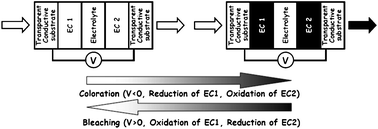A comprehensive benchmark analysis has been performed on five electrically controlled state-of-the-art transmittance modulation devices including their production routes, from ‘cradle-to-gate’. The benchmarks have been modeled employing the GaBi life cycle assessment software tool, which successfully yielded the most important environmental problem areas for the product life cycles of electrochromic and electrotropic light-modulating devices. In terms of the energy demand of processing, all-solid-state technology was found to be less favorable than wet-chemical electrodeposition processes; however, the effect is interestingly overcompensated for by the resource depletion resulting from higher layer thicknesses in the latter case. As opposed to the mineral-glass based benchmarks, a plastic-film based system was particularly favorable, implying that the substrate is a factor with a strong environmental impact in transmittance modulation devices. Eventually, very high impacts were found for tin-doped indium oxide (ITO) and iridium oxide, i.e. a common transparent conductor and anodic electrochromic material, respectively. The results obtained support important current trends such as in-line manufacturing of electrochromic devices, the quest for ITO replacement materials, and, in general, the replacement of energy- and resource-intensive processes (sputter deposition of heavy metal oxides) by less demanding methods.

You have access to this article
 Please wait while we load your content...
Something went wrong. Try again?
Please wait while we load your content...
Something went wrong. Try again?


 Please wait while we load your content...
Please wait while we load your content...